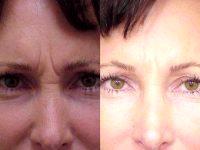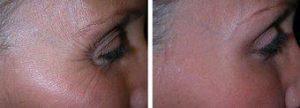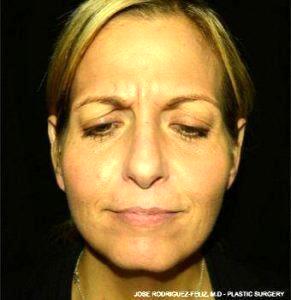Can Botox Have Side Effects?
BOTOX injections are the number 1 non surgical cosmetic procedure performed in the United States. BOTOX side effects are best avoided when a highly experienced Board Certified Plastic Surgeon or Dermatologist administers it.
The outcome is dependent on the proper number of Botox units injected precisely into the superficial facial muscles with a tiny needle and the pattern of injections into these muscles.
Knowledge of the facial anatomy and experience of the physician will consistently lead to natural results with minimal side effects like bruising, inflammation and drooping of the eyebrow or eyelids.
Ideally, the patients will not take Asprin or Motrin a week before their BOTOX injections to minimize bruising.
I generally recommend that the patients do not exercise for the rest of the day after the BOTOX injections in order to avoid bruising. The following day the patient can resume their usual exercise without concern.
Careful injections and a doctor’s “light touch” will significantly minimize the chance of drooping which is less than 1%. (Richard Wellington Swift, MD, New York Plastic Surgeon)
Avoidance of Botox Side Effects
The main side effects of botox are listed below with possible solutions to avoid each:
1. Bruising – Avoid blood thinners prior to an injection, both before and after. If you have a propensity to bruise, speak openly with your physician to see if there are any other therapies your injector can use to help decrease bruising. Bruising can happen with botox, but is uncommon.
2. Brow ptosis – Brow ptosis is more common than eyelid ptosis. Brow ptosis occurs when botox is injected above the lateral brow. In some cases, patients may have strong lines directly above the brow. Lighter application of botox here can help, but some patients can still be quite sensitive to botox here. The variability in facial anatomy and responsiveness to botox can be quite extreme.
3. Eyelid ptosis – Eyelid ptosis is quite rare. Knowledge of facial anatomy can help in avoidance of this issue. (Anil R. Shah, MD, Chicago Facial Plastic Surgeon)
Side effects from the actual drug (Botox) are not common. Allergic reactions to any of its component is possible but extremely rare. The best way to prevent droopy eyelids after your Botox is to find someone that has experience and has good technique.
Avoid areas that are tough to treat such as under the eyes where the risks are more than the potential benefits. Do your research and find a good injector with a specialty in Plastic Surgery, Facial Plastic Surgery, Dermatology, and or Oculoplastic Surgery. (Jose Rodríguez-Feliz, MD, Miami Plastic Surgeon)
Botox Side Effects
The result of Botox is largely dependent on finding a skilled and experienced physician to do the injections. One of the most common mistakes that can be made with Botox injections is using too many units which can create heavy eyelids.

Forehead Lines By Doctor A. H. Nezami, MD, Jacksonville Plastic Surgeon
I always opt to start with a more conservative number of units, and then increase as needed. This helps to ensure that my patients receive the correct dosage to treat their specific concerns. Keep in mind, that if you are getting Botox for the first time, it can take a few treatments to find the perfect number of units for you.
The more experienced the injector, the better chance of getting it right the first time. Having a consultation that includes a comprehensive facial analysis usually leads to better treatments by avoiding injections in unnecessary locations and placing Botox in appropriate locations.
Sometimes, after analysis it may be determined that the patient may actually benefit from other treatments to get best results. Patients who do experience droopy eyelids from Botox injections are not at any medical risk, but it is a nuisance.

Botox And Juvederm With Dr Gregory Pippin, MD, Metairie Facial Plastic Surgeon
The good news is that it usually starts to get better in the few weeks following the injections. Do your research to find an expert injector and enjoy the results of your treatment! (Babak Azizzadeh, MD, Beverly Hills Facial Plastic Surgeon)
In order to avoid any side effects or complications with Botox injections, the most important thing to consider is your surgeon’s credentials and training. Be sure to go to a board-certified plastic surgeon, facial plastics surgeon or dermatologist who has extensive experience with not only Botox, but other facial cosmetic injections.
In the unlikely event of a complication, a surgeon with sufficient training and experience will know how to handle any issues. We also like to tell our patients to avoid intense activity for twenty four hours and avoiding lying down for four to six hours after injection.

Botox With Doctor John W. Bass, MD, Phoenix Plastic Surgeon
With that being said, even the most experienced injectors will get a complication, such as an eyelid ptosis (drooping) from time to time. (Brian Harmych, MD, Cleveland Facial Plastic Surgeon)
Side Effects Following Botox – How to Minimize Them
Fortunately, it’s unusual for patients to experience side effects from botox treatments. Occasionally patients are unhappy with their aesthetic result and require additional botox, but this is relatively rare. The major side effects associated with botox injections are related to migration of botox into surrounding structures.
This most frequently occurs when botox drifts downward and adversely impacts the elevators of the eyelid. This ultimately results in a droopy eyelid. This complication can be minimized by carefully following post procedure instructions and carefully selecting an injector.
The qualifications of the injector are especially important since this complication is related to technical skill. It’s therefore important to know your providers qualifications, training certification and experience. It’s also important to follow post procedure instructions meticulously to avoid this complication.
Failure to follow these instructions can result in migration of botox. If these steps are taken the potential for botox complications should be minimal. (Richard J. Bruneteau, MD, Omaha Plastic Surgeon)
Avoid bad side effects by going to a skilled injector
The most important thing is to go to an experienced and skilled injector! An experienced injector should:
- listen to your concerns
- evaluate YOUR face
- customize each treatment (cookie cutter treatments do not produce the best results!)
- ask to see you back, so that she can follow up and make sure that everything turned out well. (Melissa Chiang, MD, FAAD, Houston Dermatologic Surgeon)
BOTOX side effects in the hands of an experienced and trained dermatologist or plastic surgeon is quite uncommon. The main side effects would be a slight discomfort (like a mosquito bite), tiny bruise, the occasional headache, and rarely a drooping of the eyelid or eyebrow.
A “spock brow” can also occasionally occur but is very easily fixed. In trained hands, these problems are uncommon, easily fixed, or quickly resolve on their own. (Benjamin Barankin, MD, FRCPC, Toronto Dermatologic Surgeon)
Botox, like any other medication, can cause side effects. Though it seems very simple, there is both art and science to Botox treatments. A well-trained provider will start with conservative doses for your first treatment, see how you react, and then consider adding more later or increasing the doses at your second session.
In terms of droopy eyelids or a sagging eyebrow, this results from placement of a Botox injection that is either too much for the muscle mass in the lateral forehead, or too low (too close) to the brow.
For my patients, I recommend that the lateral brow be treated conservatively and with injections placed high in the forehead, near the hairline. Other ways to get a great result include avoidng massage or significant cardiovascular activity for about a day after injections; this can help limit accidental spread of the dose. (Evan Ransom, MD, FACS, Bay Area Facial Plastic Surgeon)


